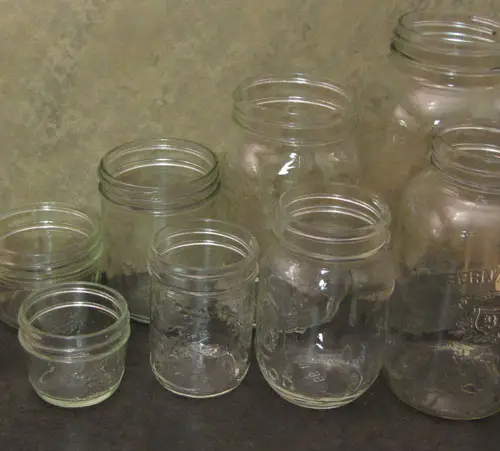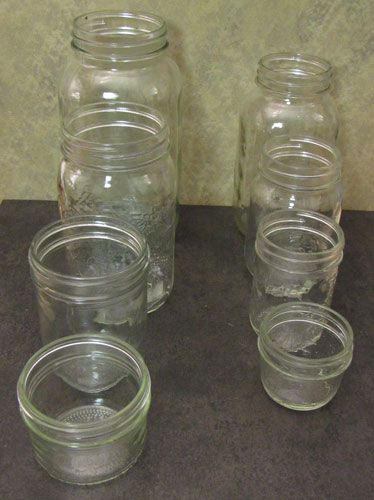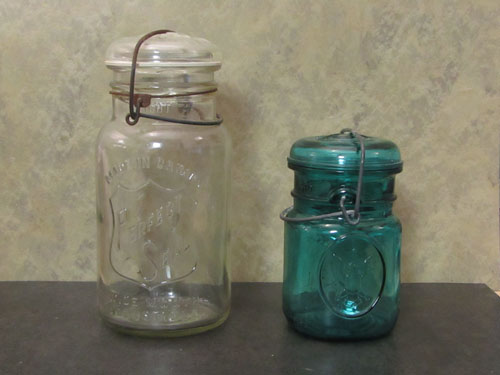This post contains affiliate links.

Glass jars are a fermenters best friend. They are easy to clean, can be sterilized and are nonreactive to the various acids which are produced during fermentation. They also come in all shapes and sizes so the size of jar can match the amount of vegetables put in it. They are easy to come by as they are still used regularly to contain canned foods from the grocer and can still be purchased from retailers for canning and other purposes.
First and most important
Glass is a brittle material which can break into tiny pieces which are sharp and can cause serious injury. When using glass containers for fermentation follow these guidelines to avoid injury.
Only use jars meant to hold pressure for a carbonated fermentation
This is not usually a concern when fermenting vegetables because carbonating vegetables is not appropriate. Carbonation requires a bottle which is designed to hold pressure. These are usually bottles which hold carbonated beverages not vegetable ferments.
Using bottles not meant for pressure can be dangerous as the pressure has been known to burst the bottle and send shards of glass flying. Only use bottles which are designed to withstand pressure for carbonating liquids
Ensure the proper seal is used while the fermentation as active
Although Mason jars and other glass containers are used for fermenting everything from sauerkraut to vinegar they do not perform well under pressure. When fermenting vegetables there is a fair amount of CO2 gas which needs to escape. This can be accomplished using a number of methods:
- Burp the jar regularly to release the pressure
- Use a bag of water to allow gas to flow out but not back in to the jar
- Use a fermentation lid which allows gas to flow out but not back in
- Use a jar with a lid which releases pressure once it reaches a certain level
Once the fermentation has slowed and you are happy with the flavor you can store it in the fridge with a normal lid.
Inspect jars for imperfections in the glass
This includes scratches, pits, cracks or thin walls everywhere or in localized places. Scratches and pits can harbor spoilage bacteria which can wreck a fermentation. Cracks are signs of weakness in the jar and even if it does not leak (which it probably does) will lead to breakage and loss of a batch (not to mention the mess which will result).
Thin walls are especially troublesome because they make the jar susceptible to breakage without warning. This usually happens when hot liquids are poured into the jar or a full jar is being transported from one place to another. Only use tempered glass jars for hot liquids and minimize the number of times the jar is moved.
Now for the benefits
Can be easily cleaned
Glass jars are hard enough to withstand most kitchen scouring pads without scratching which makes them a good choice for reusable containers for fermenting. Having a smooth surface is important for fermentation because it helps to keep the container free from lurking spoilage bacteria which can destroy a batch.
Glass jars are nonporous so they can also be soaked in cleaning solutions and not absorb chemicals which can hinder bacterial growth as well and add unpleasant flavors to the ferment. They can also be put in the dishwasher as they will not melt, deform or breakdown.
Can be sanitized using a number of methods
Sanitization using chemicals:
The chemical means usually uses chlorine or potassium or sodium metabisulfite. Chlorine is simply bleach and potassium and sodium metabisulfite can be found at your local wine making store.
To use these simply dilute the chemical in water and rince the jar with the solution. If you are using bleach it is a good idea to rince with filtered water after the bleach solution or let the jar dry for an hour or two to let the chlorine dissipate.
Sanitization using heat:
Sanitizing in the dishwasher:
The dishwasher is unable to raise the temperature enough to destroy all microorganisms which is the definition of sterilization. To do that it would need to pressurize the chamber and raise the temperature to at least 121 degrees Celsius or 250 degrees Fahrenheit. The following procedure will sanitize the jars which will destroy most microorganisms but not all.
- Clean out the food trap in the bottom of the dishwasher and then run the dishwasher empty on the pots and pans cycle to reduce the amount of food particles circulating in the dishwasher.
- Load the jars into the dishwasher and choose the pots and pans cycle with heat dry option chosen (some dishwashers have a sanitize option).
- When the dishwasher has finished its cycle remove the jars by only touching the outside of the jar.
Sanitizing on the stovetop:
- In a large canning pot or stock pot place a wire rake on the bottom and about an inch of water
- Place the jars into the pot and bring the water to a boil
- Boil the jars for 5 minutes being careful to not boil the pot dry
- Remove the jars carefully from the pot to cool
Can be sterilized
Although it is not necessary to sterilize your fermentation containers it is nice to know that glass can be sterilized through the use of the oven. Unlike other containers commonly used for fermentation glass can be heat sanitized because it can withstand high temperatures without distortion or weakening the container. Sterilization needs a temperature of at least 250 degrees F.
Sterilizing glass jars in the oven
- Preheat the oven to 250 to 270 degrees F
- Place the clean jars into the oven right-side up
- Heat the jars for 10-15 minutes until they are up to temperature
- Turn the oven off and let the jars cool before removing them to a dry surface
Are non-reactive
Glass does not react with the chemicals which are placed in it and it is nonporous. Unlike plastic which is porous and absorbs some of the liquid which is placed into it or metal which reacts with acidic liquids. This makes glass reusable for a variety of ferments without the concern for off flavors or odors persisting from prior fermentations, cleaning solutions or reactions with the container walls.
Are easy to come by
Glass jars can be salvaged from your recycling bin, purchased at garage sales, second hand stores or if you are in a hurry from retail stores. You will be surprised how many you find if you keep your eyes open. They hold tomato sauce, pickles, condiments and all sorts of other things. Glass mason jars are everywhere once you start looking.
Since they are easily cleaned you can get glass jars from any source just as long as you wash them thoroughly and inspect them before you use them the first time.
Come in a variety of shapes and sizes

The humble Mason jar alone comes in at least 7 different sizes from a 4oz jar to a half a gallon as well as in two different styles, wide mouth and small mouth. These jars are great for beginning fermenters as they are strong and durable with many choices for lids which include:
- cloth and an elastic band for aerobic ferments
- plastic backed metal lids
- reusable plastic lids
- special fermenting lids which let the CO2 gas escape and not build up pressure
Jem jars have a different sized lid between the two Mason jar types but uses the same principle for sealing the contents. They can be used just like Mason jars for fermentation
Next there are all the jars which can be salvaged from the recycling which range from tiny glass jars which hold honey, jam or jelly jars which are sold at specialty stores to gallon jars which pickles come in. You will find jars which are round, square and hexagonal. Be careful to only keep jars which are easily cleaned and do not have decorative shapes. Decorative jars are usually cheap glass which can break easily. Stick with jars meant for foods like pickle jars, glass water bottles, jam and honey jars. If it was sold as a container for a food item then it will be safe for home fermentation.
Large glass containers which are used for beverages with a spout at the bottom can be used. They come in sizes from half a gallon to over 3 gallons and more. Just be careful to inspect these jars carefully as the glass may not be high quality and vary in thickness or be too thin for repeated use.

Then there are old style canning jars which have a glass lid and a rubber seal. They are held tight with a wire arrangement simmilar the current Fido type jars. These are great for holding a finished fermentation in a decorative and functional container but because of the chance of pressure buildup in the initial stages of fermentation reserve these rare containers for less risky purposes.
The Fido jars are fantastic jars for fermenting vegetables as they maintain an anaerobic environment (without oxygen) while letting the CO2 gas which builds up to escape before the pressure is high enough to burst the jar. They have a rubber seal which if it is washed properly can be reused.
The seal can easily be replaced with a new one if it starts to get brittle, still has the smell of a fermentation after being washed or is damaged in some way. The seals are inexpensive and available at most hardware stores or online.
Glass jars are environmentally friendly
This seems a little counter intuitive because the amount of energy it takes to make a glass jar is higher than containers made out of plastic but there is more to being environmental friendly then energy usage at production time.
Reusability
Glass jars can be reused indefinitely if they are taken care of properly. The glass is tough and withstands some abuse from cleaning, storing and dropping the jars. To properly care for your jars to increase their usable lifespan follow these guidelines:
- Wash the jars immediately after use with a bristle brush
Dirty encrusted jars are more likely to be thrown away just because of the effort it would take to clean them. To avoid this wash the jars right after they are emptied.
- Replace the lid on the jar before storage
Jars which have chipped edges are unusable because they no longer seal properly. This can lead to spoilage bacteria entering the ferment and destroying a batch. By replacing the lid on the jar the lip protected from damage.
- Avoid rapid temperature changes
Glass is an amorphous solid which reacts differently to temperature changes then a normal solid would. Placing a hot jar on a cold surface or a hot liquid into a cold jar can cause it to shatter. Jars meant for canning are safe most of the time but other jars salvaged from the recycling may not be. To avoid this either preheat the jar or cool the liquid before putting them together
Recyclable
Once a jar has outlived its usefulness as a fermenting vessel it is recyclable. The glass in the jar can be used to make new glass jars saving energy and the environment. It takes less energy to manufacture new jars from old glass then from raw materials. Another benefit is less sand needs to be dug up and transported to the glass processing plant.
Less damage to the environment
If all else fails and the jar gets thrown away and lands in a land fill it does not poison the ground. It will eventually breakdown into sand again. If it ends up in the ocean it will sink and get broken down by wave action (which is how the sand was made in the first place) unlike plastic which continues to poison the environment long after its useful life has passed.

